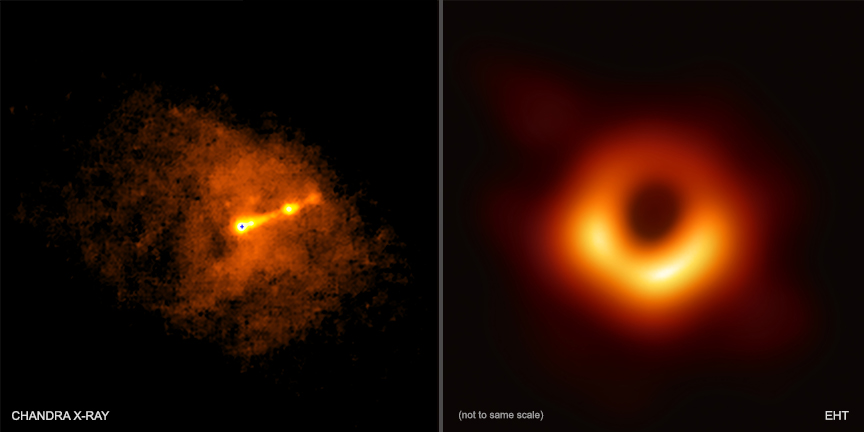
 Credit: X-ray: NASA/CXC/Villanova University/J. Neilsen; Radio: Event Horizon Telescope Collaboration
Credit: X-ray: NASA/CXC/Villanova University/J. Neilsen; Radio: Event Horizon Telescope Collaboration
Picturing Darkness
Active galaxies are some of the most luminous objects in the known Universe. They are characterised by extreme emission of high energy radiation and particles, and wild variations on surprisingly short timescales. It's been assumed for decades that the only engine powerful and small enough to explain these extremes is a black hole, a region of gravity so intense that not even light can escape. It's been a dream of scientists to confirm this assumption by taking a picture of a black hole at the center of an active galaxy. But how do you take a picture of something that neither emits nor reflects light? Black holes are powered by accretion of matter from a swirling, hot disk that surrounds them. These accretion disks emit light which can, in principle, be imaged. The key signature of an accretion disk around a black hole would be detecting the black hole's "shadow", the region of blackness at the center of the disk from which no light can escape. You probably have already seen the image on the right, the now-famous first ever image of the shadow of the supermassive black hole lurking at the center of the active elliptical galaxy known as M87. This image was obtained through a heroic effort of observational coordination and massive data analysis by the international Event Horizon Telescope Collaboration, using a global network of synchronized radio telescopes to generate an extremely magnified view of the center of M87. The shadow in this image is only a few times larger than our solar system. At the distance of M87 (about 55 million lightyears), this is equivalent to standing on earth and being able to see the image of George Washington on a quarter on the Moon. Amazingly, the size of the shadow shows that this tiny object has a mass equivalent to about 6 billion solar masses. It generates such enormous energy that it disturbs its entire host galaxy and far beyond. The image on the left is a contemporaneous image of the X-ray emission centered on the black hole in M87, obtained by the Chandra X-ray Observatory. It's currently not possible to directly image the M87's tiny black hole in X-rays with existing technology. Rather, images with Chandra show the power of the black hole on much larger spatial scales and much higher energies. Particularly noticeable near the center of the image is the bright X-ray emission generated very near the black hole, along with a powerful, highly-collimated X-ray emitting jet of charged particles produced by the black hole, extending to the upper right for thousands of lightyears. Farther out, careful analysis of the diffuse X-ray emission surrounding M87 shows ripples in the hot, X-ray emitting gas probably produced by enormous outbursts of the central black hole in M87 in the dim and distant past. Look forward to images of other black hole shadows in other galaxies (including our own) and coordinated studies to show how variations in the black hole's feeding frenzy ripple through intergalactic space.
Published: April 15, 2019
<
HEA Dictionary ● Archive
● Search HEAPOW
● Other Languages
● HEAPOW on Facebook
● Download all Images
● Education ● HEAD
>

Each week the HEASARC
brings you new, exciting and beautiful images from X-ray and Gamma ray
astronomy. Check back each week and be sure to check out the HEAPOW archive!
Page Author: Dr. Michael F. Corcoran
Last modified Monday, 26-Feb-2024 17:22:33 EST


